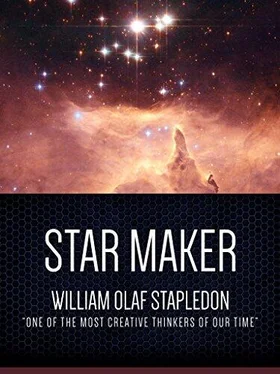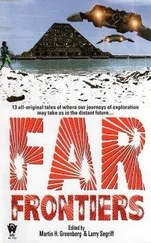The emotional attitude of the worlds had also changed. The fervor for the establishment of cosmical Utopia had vanished, and with it the fervor for the completion of the spirit's adventure by the fulfilment of knowledge and creative capacity. Now that extermination seemed inevitable within a comparatively short time, there was an increasing will to meet fate with religious peace. The desire to realize the far cosmcal goal, formerly the supreme motive of all awakened worlds, now seemed to be extravagant, even impious. How should the little creatures, the awakened worlds, reach out to knowledge of the whole cosmos, and of the divine. Instead they must play their own part in the drama, and appreciate their own tragic end with godlike detachment and relish.
This mood of exultant resignation, appropriate to unavoidable disaster, quickly changed under the influence of a new discovery. In certain quarters there had long been a suspicion that the irregular activity of the stars was not merely automatic but purposeful, in fact that the stars were alive, and were striving to rid themselves of the pest of planets. This possibility had at first seemed too fantastic; but it gradually became obvious that the destruction of a star's planetary system was the end which determined the duration of the irregular action. Of course it was possible that in some unexplained but purely mechanical way the presence of many planetary girdles created the explosion, or the fiery limb. Astronomical physics could suggest no mechanism whatever which could have this result. Telepathic research was now undertaken in order to test the theory of stellar consciousness, and if possible to set up communication with the minded stars. This venture was at first completely barren. The worlds had not the slightest knowledge of the right method of approach to minds which, if they existed at all, must be inconceivably different from their own. It seemed all too probable that no factors in the mentality of the minded worlds were sufficiently akin to the stellar mentality to form a means of contact. Though the worlds used their imaginative powers as best they might, though they explored, so to speak, every subterranean passage and gallery of their own mentality, tapping everywhere in the hope of answer, they received none. The theory of stellar purposefulness began to seem incredible. Once more the worlds began to turn to the consolation, nay the joy, of acceptance. Nevertheless, a few world-systems that had specialized in psychological technique persisted in their researches, confident that, if only they could communicate with the stars, some kind of mutual understanding and concord could be brought about between the two great orders of minds in the galaxy. At long last the desired contact with the stellar minds was effected. It came not through the unaided efforts of the minded worlds of our galaxy but partly through the mediation of another galaxy where already the worlds and the stars had begun to realize one another.
Even to the minds of fully awakened worlds the stellar mentality was almost too alien to be conceived at all. To me, the little human individual, all that is most distinctive in it is now quite incomprehensible. Nevertheless, its simpler aspect I must now try to summarize as best I may, since it is essential to my story. The minded worlds made their first contact with the stars on the higher planes of stellar experience, but I shall not follow the chronological order of their discoveries. Instead I shall begin with aspects of the stellar nature which were haltingly inferred only after intercourse of a sort had become fairly well established. It is in terms of stellar biology and physiology that the reader may most easily conceive something of the mental life of stars.
3. STARS
Stars are best regarded as living organisms, but organisms which are physiologically and psychologically of a very peculiar kind. The outer and middle layers of a mature star apparently consist of "tissues" woven of currents of incandescent gases. These gaseous tissues live and maintain the stellar consciousness by intercepting part of the immense flood of energy that wells from the congested and furiously active interior of the star. The innermost of the vital layers must be a kind of digestive apparatus which transmutes the crude radiation into forms required for the maintenance of the star's life. Outside this digestive area lies some sort of coordinating layer, which may be thought of as the star's brain. The outermost layers, including the corona, respond to the excessively faint stimuli of the star's cosmical environment, to light from neighboring stars, to cosmic rays, to the impact of meteors, to tidal stresses caused by the gravitational influence of planets or of other stars. These influences could not, of course, produce any clear impression but for a strange tissue of gaseous sense organs, which discriminate between them in respect of quality and direction, and transmit information to the correlating "brain" layer.
The sense experience of a star, though so foreign to us, proved after all fairly intelligible. It was not excessively difficult for us to enter telepathically into the star's perception of the gentle titillations, strokings, pluckings, and scintillations that came to it from the galactic environment. It was strange that, though the star's own body was actually in a state of extreme brilliance, none of this outward-flowing light took effect upon its sense organs. Only the faint in-coming light of other stars was seen. This afforded the perception of a surrounding heaven of flashing constellations, which were set not in blackness but in blackness tinged with the humanly inconceivable color of the cosmic rays. The stars themselves were seen colored according to their style and age. But though the sense perception of the stars was fairly intelligible to us, the motor side of stellar life was at first quite incomprehensible. We had to accustom ourselves to an entirely new way of regarding physical events. For the normal voluntary motor activity of a star appears to be no other than the star's normal physical movement studied by our science, movement in relation to other stars and the galaxy as a whole. A star must be thought of as vaguely aware of the gravitational influence of the whole galaxy, and more precisely aware of the "pull" of its near neighbors; though of course their influence would generally be far too slight to be detected by human instruments. To these influences the star responds by voluntary movement, which to the astronomers of the little minded worlds seems purely mechanical; but the star itself unquestioningly and rightly feels this movement to be the freely willed expression of its own psychological nature. Such at least was the almost incredible conclusion forced on us by the research carried out by the Galactic Society of Worlds.
Thus the normal experience of a star appears to consist in perception of its cosmical environment, along with continuous voluntary changes within its own body and in its position in relation to other stars. This change of position consists, of course, in rotation and passage. The star's motor life is thus to be thought of almost as a life of dance, or of figure-skating, executed with perfect skill according to an ideal principle which emerges into consciousness from the depths of the stellar nature and becomes clearer as the star's mind matures.
This ideal principle cannot be conceived by men save as it is manifested in practice as the well-known physical principle of "least action," or the pursuit of that course which in all the gravitational and other conditions is the least extravagant. The star itself, by means of its purchase on the electromagnetic field of the cosmos, apparently wills and executes this ideal course with all the attention and delicacy of response which a motorist exercises in threading his way through traffic on a winding road, or a ballet-dancer in performing the most intricate movements with the greatest economy of effort. Almost certainly, the star's whole physical behavior is normally experienced as a blissful, an ecstatic, an ever successful pursuit of formal beauty. This the minded worlds were able to discover through their own most formalistic aesthetic experience. In fact it was through this experience that they first made contact with stellar minds. But the actual perception of the aesthetic (or religious?) rightness of the mysterious canon, which the stars so earnestly accepted, remained far beyond the mental range of the minded worlds. They had to take it, so to speak, on trust. Clearly this aesthetic canon was in some way symbolical of some spiritual intuition that remained occult to the minded worlds.
Читать дальше









![Олаф Стэплдон - Создатель звезд [сборник litres]](/books/433148/olaf-stepldon-sozdatel-zvezd-sbornik-litres-thumb.webp)


